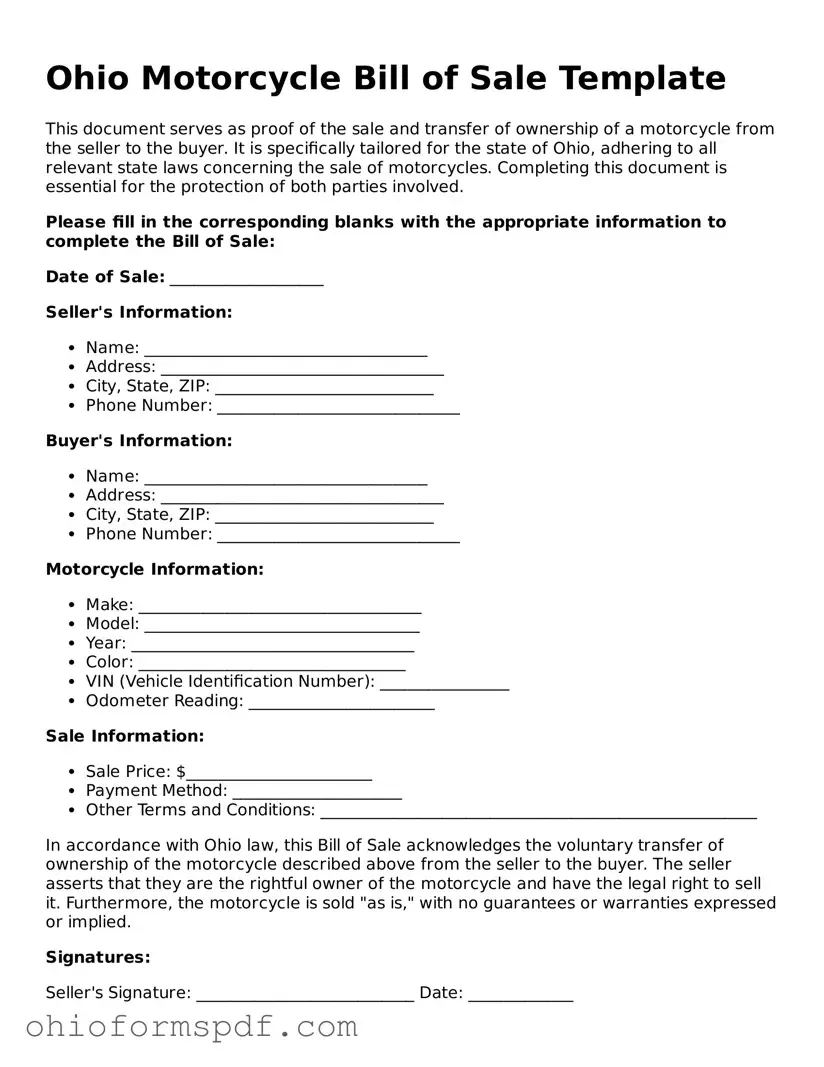What is an Ohio Motorcycle Bill of Sale form?
An Ohio Motorcycle Bill of Sale form is a legal document that records the sale and purchase transaction of a motorcycle in the state of Ohio. This document provides vital information such as the description of the motorcycle, the sale price, and the names and signatures of both the buyer and the seller. It serves as evidence of the transfer of ownership.
Is the Ohio Motorcycle Bill of Sale form required for the sale of a motorcycle?
While Ohio law does not explicitly require a bill of sale for the sale of a motorcycle, it is highly recommended to have one. It provides a record of the transaction and can be useful for title transfer, registration, and tax purposes. Plus, it offers legal protection to both parties in case of disputes.
What information should be included in the Ohio Motorcycle Bill of Sale form?
The form should include the full names and addresses of both the buyer and the seller, a detailed description of the motorcycle (including make, model, year, and VIN), the sale price, the date of sale, and statements regarding the motorcycle's warranty status. It should also have a place for both parties to sign and date.
Do both the buyer and the seller need to sign the Ohio Motorcycle Bill of Sale form?
Yes, for the document to be considered valid and effective, both the buyer and the seller must sign the Ohio Motorcycle Bill of Sale form. It's recommended that the signatures be notarized, although not required, to add an extra layer of authenticity.
Should the Ohio Motorcycle Bill of Sale form be notarized?
Notarization is not a legal requirement in Ohio for a Motorcycle Bill of Sale, but it is advisable. Notarizing the document can help prevent legal issues by verifying the identity of the signatories and confirming their agreement to the terms of the sale.
Can I create an Ohio Motorcycle Bill of Sale form myself?
Yes, you can create an Ohio Motorcycle Bill of Sale form yourself, as long as it contains all the required information as mentioned above. There are also many templates available online that you can use as a guide. However, ensure that the form complies with Ohio laws and includes all necessary details.
What happens after the Ohio Motorcycle Bill of Sale form is signed?
After the form is signed, the buyer should use it, along with other required documents, to transfer the title into their name and register the motorcycle with the Ohio Bureau of Motor Vehicles (BMV). Both parties should keep a copy of the Bill of Sale for their records.
Is the Ohio Motorcycle Bill of Sale form sufficient for title transfer?
No, the Ohio Motorcycle Bill of Sale form alone is not sufficient for title transfer. The buyer must present this form along with the motorcycle's title, properly endorsed by the seller, and other required documents to the Ohio BMV to complete the title transfer.
What if the motorcycle is bought or sold without an Ohio Motorcycle Bill of Sale?
While the transaction can still occur, not having a Bill of Sale may complicate the title transfer and registration process and potentially create legal disputes regarding the motorcycle's ownership or sale terms. It's in both parties' best interest to complete and sign a Bill of Sale.
Where can I find a template for an Ohio Motorcycle Bill of Sale form?
Templates for an Ohio Motorcycle Bill of Sale form can be found online through legal resources websites, template repositories, or the Ohio Bureau of Motor Vehicles (BMV) website. Make sure to use a template that includes all necessary information and complies with Ohio laws.
